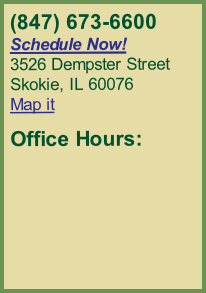


9am -
3pm -
M/W/Th:
3pm -
9am -
8am -
1st & 3rd Saturdays only
Tues:
Fri:
Sat:





If you have any questions regarding massage therapy or would like an appointment, please call us at
(847) 673-
Office Hours:
M/W/Th:
9am-
Tues:
3pm-
Fri:
9am-
Sat:
8am-
By Brenda Goodman, WebMD Health News
Massage may be serious medicine, at least when it comes to treating persistent low back pain, a new study shows.
Low back pain is one of the top reasons people seek medical attention in the U.S., and it is notoriously tough to treat. Studies show very few medical therapies, from medications to injections to surgeries, reliably relieve it, and some can aggravate the problem.
The new study randomly assigned 400 adults with moderate-
People assigned to the usual care group were tracked by researchers, but they dealt with their back problems on their own. The approach could include, for instance, taking pain medications or muscle relaxants, seeing doctors or chiropractors, physical therapy, or simply not doing anything.
After 10 weeks, participants in both massage groups reported greater average improvements in pain and functioning compared to those in the usual care group. And the type of massage they received didn't seem to matter.
That's good news, researchers say, because relaxation, or Swedish-
For most, the improvements seen with massage were modest.
Daily functioning, for example, improved, on average, between 2 to 4 points on a
23-
Experts say that's a bit better than the degree of benefit that most people see from
taking over-
But for a substantial minority, however, the improvements were much greater.
At the end of the 10-
"It's not really harmful, and it does help a significant chunk of people who have not benefited from other treatments," says study researcher Daniel C. Cherkin, PhD, associate director and senior scientific investigator with the Center for Health Studies at Group Health Cooperative in Seattle.
The study was funded by the National Center for Complementary and Alternative Medicine. It's published in the Annals of Internal Medicine.
"I think this trial is good news in the sense that it suggests that massage is a useful option that helps some substantial fraction of these patients," says study researcher Richard A. Deyo, MD, a professor in the department of family medicine at Oregon Health and Science University in Portland.
"Like in most other treatments, this is not a slam dunk, and it's not like a cure," Deyo tells WebMD, "But it's something that seems to offer a significant benefit for a substantial number of patients."
Experts who were not involved in the study agree.
Roger Chou, MD, an associate professor of medicine at Oregon Health and Science University, helped to write the 2009 American Pain Society guidelines for treating low back pain.
He says massage was recommended in those clinical practice guidelines, though the authors noted that the recommendation was based on a small number of studies and the benefits were likely to be modest.
"I think the study is quite consistent with what we have in our guideline, and it adds to the evidence that's out there," Chou says. "It strengthens the case to consider massage as one of the potential treatment options for chronic low back pain."
But Chou, and others, including the study's researchers, say exercise is likely to offer far greater benefits than massage for people who've been struggling with back pain for a long time, and they stress that people shouldn't assume that massage alone will banish low back pain for good.
"Certainly, it's not going to hurt," says Fredrick P. Wilson, DO, director of the Cleveland Clinic Solon Center for Spine Health, in Ohio.
"But it's a short-
Wilson says he would have liked to have seen more objective measures of function
included in the study, like spinal range of motion assessed by investigators, rather
than just relying on self-
But he says that on the whole, there's little harm to be had with massage, and some evidence of help. So it might be worth a try, but he says it should be coupled with exercise.
"When we see patients, we push them toward active exercise rather than passive natural therapy kind of a thing. If they can have stronger core strength to support their spine, they're going to be better off in the long run. So we're trying to fix, rather than ease, their pain," Wilson says.
Studies estimate that as many as 80% of adults will experience an episode of low back pain in their lifetimes.
In most cases, the pain will go away without any treatment in two to four weeks. About 14% of the time, however, low back pain lingers, sometimes without a readily identified cause.
Relatively few medical interventions have been proven to reliably help back pain, and it is considered to be one of the most overtreated ailments in American medicine.
"Over the last 15 years or so, there's been a steady increase in the use surgery,
prescribing of opioids, in the use of injections in the use of spine imaging," Deyo
says, "and overall, population-
That's why it's especially promising to find benefit in a noninvasive therapy like massage, he says.
The study found that the 10 treatments received by study participants would have cost about $540 in the community. Massage isn't typically covered by insurance.
The benefits appeared to persist for four months after the course of treatment was completed.
"I think it's true that wherever we can find alternatives that seem to be helpful, it's likely to be a useful thing for clinicians," Deyo says.
Study: Massage Therapy Helps Low Back Pain
All content copyright © Healing Hands Wellness & Chiropractic Center Ltd.
www.HealingHandsOfSkokie.com phone:
(847) 673-